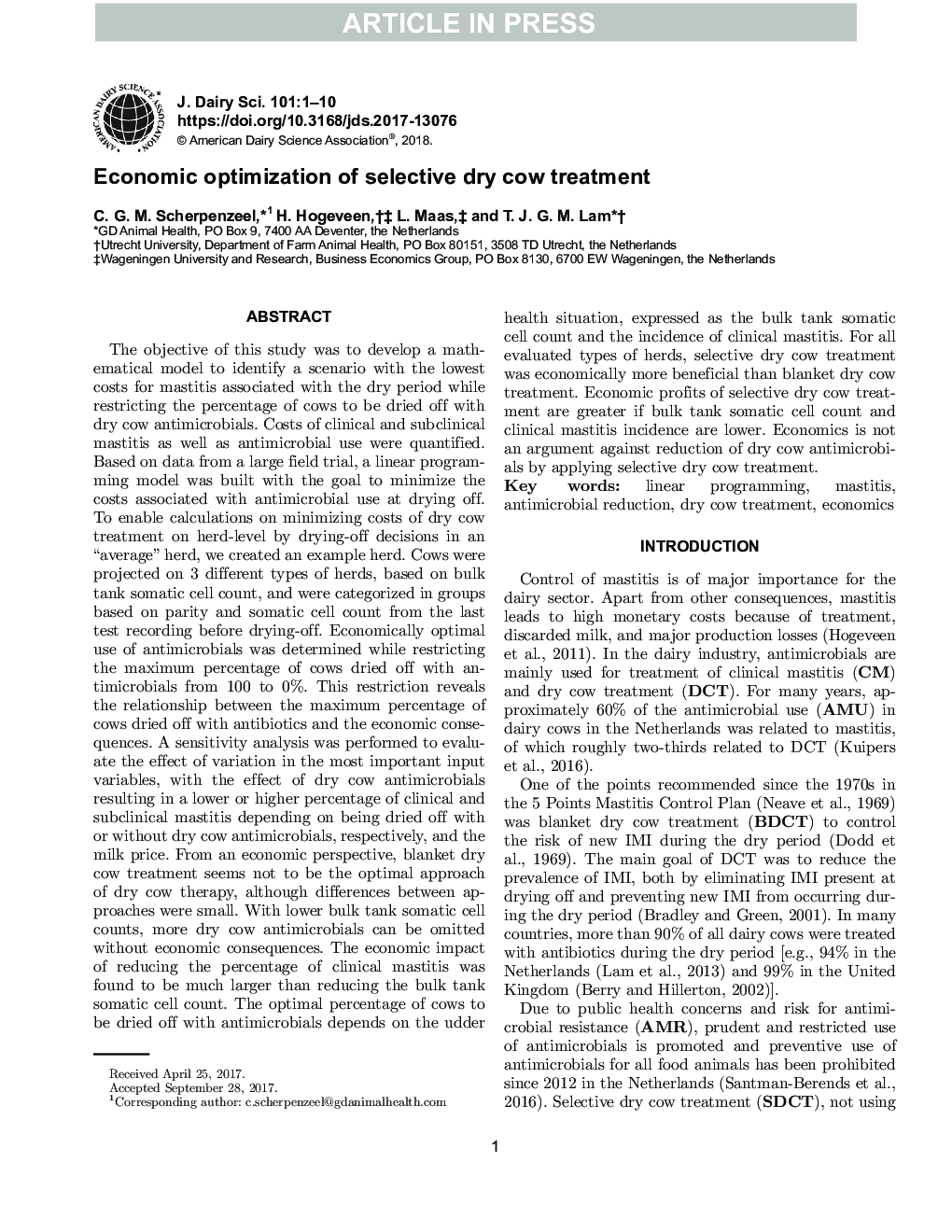| کد مقاله | کد نشریه | سال انتشار | مقاله انگلیسی | نسخه تمام متن |
|---|---|---|---|---|
| 8501694 | 1553843 | 2018 | 10 صفحه PDF | دانلود رایگان |
عنوان انگلیسی مقاله ISI
Economic optimization of selective dry cow treatment
ترجمه فارسی عنوان
بهینه سازی اقتصادی انتخاب گاو خشک گاو
دانلود مقاله + سفارش ترجمه
دانلود مقاله ISI انگلیسی
رایگان برای ایرانیان
کلمات کلیدی
برنامه ریزی خطی، ماستیت، کاهش ضد میکروبی، درمان گاو خشک اقتصاد،
ترجمه چکیده
هدف از این مطالعه، توسعه یک مدل ریاضی برای شناسایی سناریوی با کمترین هزینه برای ماستیت همراه با دوره خشکسالی بود، در حالی که محدود کردن درصد گاوهای خشک شده با ضد میکروبی خشک گاو. هزینه های ماستیت بالینی و زیر کلاسیک و همچنین استفاده از آنتی بیوتیک ها به میزان کافی بوده است. بر اساس داده های یک آزمایش بزرگ میدان، یک مدل برنامه ریزی خطی با هدف کاهش هزینه های مرتبط با استفاده از ضد میکروبی در خشک شدن ساخته شد. برای فعال کردن محاسبات برای به حداقل رساندن هزینه های درمان گاو خشک در سطح گله توسط تصمیم خشک شدن در یک میانگین؟ گله، ما گله ای را ایجاد کردیم. گاوها بر روی سه نوع مختلف گله، براساس تعداد سلول های سومات مخزن فله، پیش بینی می شدند و بر اساس تعداد سلول های سلولی و سلول های سوماتیک از آخرین ضبط آزمون قبل از خشک شدن طبقه بندی شدند. از لحاظ اقتصادی استفاده مطلوب از آنتی بیوتیک ها در حالی که محدود کردن حداکثر درصد گاوهای خشک شده با آنتی بیوتیک ها از 100 تا 0 درصد تعیین شد. این محدودیت، رابطه بین حداکثر درصد گاوهای خشک شده با آنتی بیوتیک ها و پیامدهای اقتصادی را نشان می دهد. تحلیل حساسیت به منظور ارزیابی اثر تغییر در مهمترین متغیرهای ورودی، با تاثیر ضد میکروبی خشک گاو انجام شد که در نتیجه درصد کمتر یا بالاتر از ماستیت بالینی و زیرکلیلیک را بسته به خشک کردن آنتی بیوتیک های خشک گاو یا بدون آن ، و قیمت شیر. از دیدگاه اقتصادی، درمان خشک گاو خشک، به نظر نمی رسد رویکرد مطلوب درمان خشک گاو باشد، اگرچه تفاوت بین روش ها کوچک است. با شمارش سلول های سوماتیک مخزن کمتری، ضد میکروبی های خشک گاو می توانند بدون عواقب اقتصادی حذف شوند. تأثیر اقتصادی کاهش درصد ماستیت بالینی در مقایسه با کاهش تعداد سلول های سوماتیک مخزن فله، بسیار بیشتر بود. درصد مطلوب گاوهای خشک شده با آنتی بیوتیک ها بستگی به وضعیت سلامتی یوز، بیان شده به عنوان تعداد سلول های سومات مخزن فله و بروز ماستیت بالایی است. برای تمام انواع ارزیابی شده گله، گاو انتخابی خشک گاو از لحاظ اقتصادی بیشتر از گاو خشک گاو خشک است. سود حاصل از گاوهای خشک گاو انتخابی بیشتر است، در صورتی که تعداد سلول های سوماتیک مخزن مخزن و بروز شستشوی بالینی پایین تر است. اقتصاد با استفاده از گاو خشک انتخابی بحث بر علیه کم کردن ضد میکروبی خشک گاو نیست.
موضوعات مرتبط
علوم زیستی و بیوفناوری
علوم کشاورزی و بیولوژیک
علوم دامی و جانورشناسی
چکیده انگلیسی
The objective of this study was to develop a mathematical model to identify a scenario with the lowest costs for mastitis associated with the dry period while restricting the percentage of cows to be dried off with dry cow antimicrobials. Costs of clinical and subclinical mastitis as well as antimicrobial use were quantified. Based on data from a large field trial, a linear programming model was built with the goal to minimize the costs associated with antimicrobial use at drying off. To enable calculations on minimizing costs of dry cow treatment on herd-level by drying-off decisions in an “average” herd, we created an example herd. Cows were projected on 3 different types of herds, based on bulk tank somatic cell count, and were categorized in groups based on parity and somatic cell count from the last test recording before drying-off. Economically optimal use of antimicrobials was determined while restricting the maximum percentage of cows dried off with antimicrobials from 100 to 0%. This restriction reveals the relationship between the maximum percentage of cows dried off with antibiotics and the economic consequences. A sensitivity analysis was performed to evaluate the effect of variation in the most important input variables, with the effect of dry cow antimicrobials resulting in a lower or higher percentage of clinical and subclinical mastitis depending on being dried off with or without dry cow antimicrobials, respectively, and the milk price. From an economic perspective, blanket dry cow treatment seems not to be the optimal approach of dry cow therapy, although differences between approaches were small. With lower bulk tank somatic cell counts, more dry cow antimicrobials can be omitted without economic consequences. The economic impact of reducing the percentage of clinical mastitis was found to be much larger than reducing the bulk tank somatic cell count. The optimal percentage of cows to be dried off with antimicrobials depends on the udder health situation, expressed as the bulk tank somatic cell count and the incidence of clinical mastitis. For all evaluated types of herds, selective dry cow treatment was economically more beneficial than blanket dry cow treatment. Economic profits of selective dry cow treatment are greater if bulk tank somatic cell count and clinical mastitis incidence are lower. Economics is not an argument against reduction of dry cow antimicrobials by applying selective dry cow treatment.
ناشر
Database: Elsevier - ScienceDirect (ساینس دایرکت)
Journal: Journal of Dairy Science - Volume 101, Issue 2, February 2018, Pages 1530-1539
Journal: Journal of Dairy Science - Volume 101, Issue 2, February 2018, Pages 1530-1539
نویسندگان
C.G.M. Scherpenzeel, H. Hogeveen, L. Maas, T.J.G.M. Lam,
